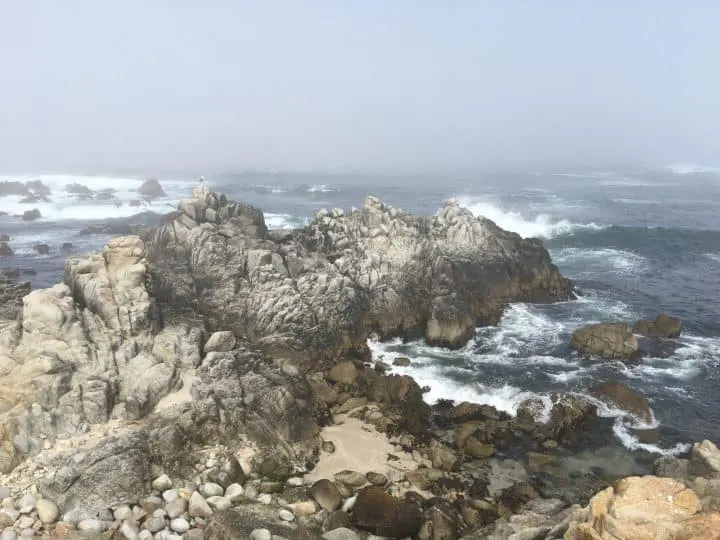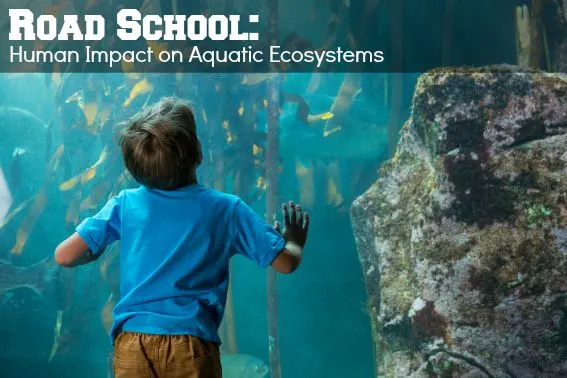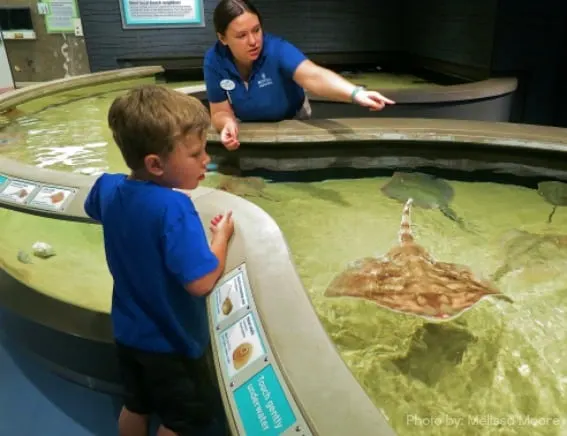As a science educator, taking my kids out in nature to experience the world has been a priority of mine since before they could walk. Despite spending as much time jumping in puddles, picking dandelions, and throwing pebbles in streams as possible, I clearly remember the first time I took my little boy, then barely a toddler, to the tide pools at the Carpinteria State Beach. After showing him how he could gently touch the sea anemones covering the nearby rocks, I walked off to show my daughter a starfish clinging to the rocks closer to the water. When I turned back around, my son had a large rock in his hand and was beginning to pound the sea anemones with the stone. At that point, I gave my son his very first biology lesson: Rocks aren’t alive, but sea anemones are living creatures; hitting them with a rock will hurt them.
Image by: Shutterstock/wavebreakmedia
Seeing and touching creatures in their native habitats is where the discussion about taking care of our bays, lakes, and oceans begins. Touching a sea anemone in a tide pool or even aquarium touch tank, spotting dolphins off the bow of a ship or a couple of turtles basking on the shore of a lake from a kayak, cooking up a Maine lobster in a pot then eating it, and picking up trash off the local beach are all activities that inspire children to want to learn more about the world around them and take care of the environment where these creatures live.
[box border=full] Sponsored by Discover Martin County
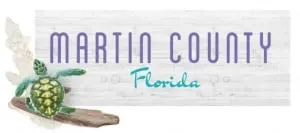 Martin County, FL enjoys an international reputation for its natural beauty and environmental stewardship. Here you will find miles of white sand beaches, breathtaking outdoor venues, worldclass fishing, water sports, and ecoadventure. Home to the most biodiverse lagoon ecosystem in the Northern Hemisphere, the St. Lucie Inlet this is the conduit between the Atlantic Ocean and the Indian River Lagoon. This ecosystem provides habitat for over 4,300 species of plants and animals, including more than 30 threatened and endangered species. Discover Martin County, Florida and its adventures today.
Martin County, FL enjoys an international reputation for its natural beauty and environmental stewardship. Here you will find miles of white sand beaches, breathtaking outdoor venues, worldclass fishing, water sports, and ecoadventure. Home to the most biodiverse lagoon ecosystem in the Northern Hemisphere, the St. Lucie Inlet this is the conduit between the Atlantic Ocean and the Indian River Lagoon. This ecosystem provides habitat for over 4,300 species of plants and animals, including more than 30 threatened and endangered species. Discover Martin County, Florida and its adventures today.
Aquarium Touch Tank Experiences
Thirty years ago, the Monterey Bay Aquarium opened. Soon after the opening, my grandparents sent me a postcard from their first visit promising to take me, already totally fascinated by the sea life that I found at my local tide pools, to the brand-new aquarium. That visit is what later inspired me to volunteer as a college student at The Santa Barbara Natural History Museum’s Sea Center on Sterns Wharf, where the highlight of my day was running educational programs at the touch tank, showing kids how to feed a piece of kelp to the purple sea urchins, or pick up a well-camouflaged green kelp crab and let it scamper about on their hand. Kids will make a far more memorable connection with the squishy sea cucumber that they can hold in their hands than a television documentary on the great white shark or 3D movie about the ocean’s coral reefs.
I’m so happy that marine educators around the country have realized this important connection and provide hands-on opportunities for children! Just this past spring the National Aquarium in Baltimore opened a brand new Living Seashore exhibit. It’s like walking onto a beach and down into the intertidal zone with a naturalist right there holding your hand. Kids can look through a set of binoculars and see images of shore birds or dig through digital sand using a computerized magnifying lens to learn about the critters that live there. Of course, the highlight of the new exhibit is the state of the art touch tanks, including the only touch tank I have ever seen where visitors can actually hold a jelly fish. (Editor’s note: The Aquarium of the Pacific in Long Beach also boasts the chance to hold and touch Jellies.) The aquarium also inspires children to act by displaying stories of what others have done to clean up and protect the bay and thoughtfully asking visitors what they can do. Kids will leave the aquarium wanting to go out to their local beaches to explore and conserve, and due to the clever digital displays and knowledgeable educators supervising the touch tanks, they will know the names of the animals that they find out there.
Visiting tide pools is an excellent way to learn about local sea creatures: Here’s Trekaroo’s guide to The Best Tide Pools in California for Kids.
Boating and Kayaking
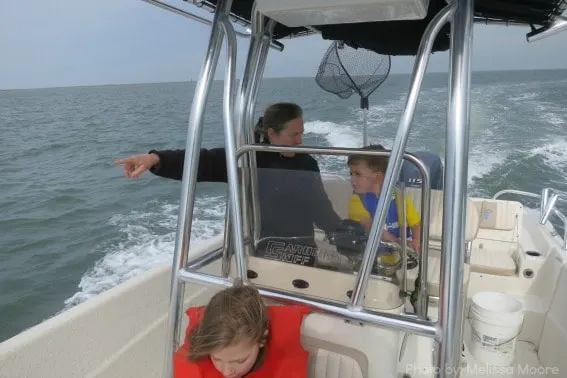 This spring my kids and I took a boat ride to Virginia’s Barrier Islands. We searched for shells on a small island and watched the birds nesting in the wetlands, but all of that was put on hold once we spotted a pod of dolphins. There’s something about being out on a boat and watching dolphins play that draws children into the dolphin’s world and away from their own. Seeing the surprise and excitement in my kids’ faces and later reading my daughter’s school journal entry about the boat ride, brought me back to my own childhood experience of spotting dolphins off the California coast when my dad took me on a trip to the Channel Islands just miles by boat from Santa Barbara. I too wrote about my experience watching the dolphins swim alongside our boat on the way back home. Whether it’s a motor boat ride to a remote island or paddling a kayak on your local lake, getting kids out on the water takes them out of their own typical routine and puts them into the habitat of all sorts of different creatures from turtles and tadpoles to dolphins and whales. Meeting animals out in their own environment creates an impact that is not soon forgotten. Looking for some opportunities for marine-life education in Central and Southern California? Check out Trekaroo’s Lists of Marine Life Education Field Trips: School-Age Kids in LA and Learning about Marine Life on California’s Central Coast.
This spring my kids and I took a boat ride to Virginia’s Barrier Islands. We searched for shells on a small island and watched the birds nesting in the wetlands, but all of that was put on hold once we spotted a pod of dolphins. There’s something about being out on a boat and watching dolphins play that draws children into the dolphin’s world and away from their own. Seeing the surprise and excitement in my kids’ faces and later reading my daughter’s school journal entry about the boat ride, brought me back to my own childhood experience of spotting dolphins off the California coast when my dad took me on a trip to the Channel Islands just miles by boat from Santa Barbara. I too wrote about my experience watching the dolphins swim alongside our boat on the way back home. Whether it’s a motor boat ride to a remote island or paddling a kayak on your local lake, getting kids out on the water takes them out of their own typical routine and puts them into the habitat of all sorts of different creatures from turtles and tadpoles to dolphins and whales. Meeting animals out in their own environment creates an impact that is not soon forgotten. Looking for some opportunities for marine-life education in Central and Southern California? Check out Trekaroo’s Lists of Marine Life Education Field Trips: School-Age Kids in LA and Learning about Marine Life on California’s Central Coast.
Taste Test
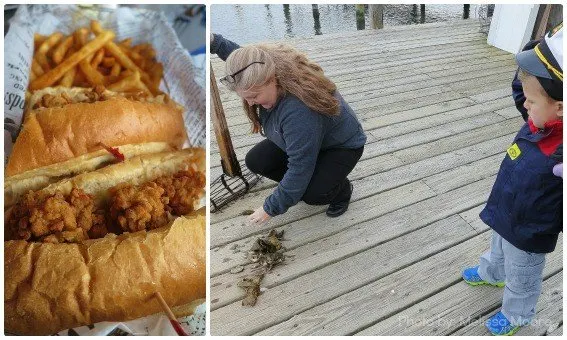 I’m not an adventurous eater. Growing up, my idea of enjoying a seafood dinner was choking down a couple of fish sticks. Maybe your young children are the same way, mine certainly are. But, thanks to my college ecology professor, who made me eat halibut and salmon in Alaska and lobster in Maine, I’ve learned to give local seafood a try. There’s so much to learn about history and culture of the area when sampling local seafood. One chilly day in December, my mom and I took my four-year-old son to visit the Chesapeake Bay Maritime Museum in St Michaels, Maryland on the Eastern Shore. We spent all morning learning about how the Chesapeake Bay’s oysters are cultivated and farmed by the local watermen through the museum’s exhibits; we were even shown the tools used for grabbing the oysters off the bottom of the bay by museum staff. Of course, the bay is also known for its blue crabs, and we searched the entire museum complex for “blue crabby” using cleverly written scavenger hunt clues to lead us to exhibits designed to teach children about the watermen of the Eastern Shore. At the end of our visit, I asked the museum staff for a lunch recommendation, and they recommended Chesapeake Landing Seafood. Before thinking, I inquired “Do they only serve seafood?” Of course, this was the wrong question to ask. The museum staff implored, “You’ve got to eat the crab,” and I quickly realized that tasting the crab was all part of the experience. Sampling the local seafood whether it is oysters, salmon, blue crab, lobster, shrimp, flounder, whitefish, or halibut is just as much a part of the experience as learning about the places where these animals live and the fishermen whose livelihoods depend upon the local seafood industry. Considering a family vacation on Virginia’s Eastern Shore? Here’s an itinerary with a couple of excellent family-friendly seafood restaurants.
I’m not an adventurous eater. Growing up, my idea of enjoying a seafood dinner was choking down a couple of fish sticks. Maybe your young children are the same way, mine certainly are. But, thanks to my college ecology professor, who made me eat halibut and salmon in Alaska and lobster in Maine, I’ve learned to give local seafood a try. There’s so much to learn about history and culture of the area when sampling local seafood. One chilly day in December, my mom and I took my four-year-old son to visit the Chesapeake Bay Maritime Museum in St Michaels, Maryland on the Eastern Shore. We spent all morning learning about how the Chesapeake Bay’s oysters are cultivated and farmed by the local watermen through the museum’s exhibits; we were even shown the tools used for grabbing the oysters off the bottom of the bay by museum staff. Of course, the bay is also known for its blue crabs, and we searched the entire museum complex for “blue crabby” using cleverly written scavenger hunt clues to lead us to exhibits designed to teach children about the watermen of the Eastern Shore. At the end of our visit, I asked the museum staff for a lunch recommendation, and they recommended Chesapeake Landing Seafood. Before thinking, I inquired “Do they only serve seafood?” Of course, this was the wrong question to ask. The museum staff implored, “You’ve got to eat the crab,” and I quickly realized that tasting the crab was all part of the experience. Sampling the local seafood whether it is oysters, salmon, blue crab, lobster, shrimp, flounder, whitefish, or halibut is just as much a part of the experience as learning about the places where these animals live and the fishermen whose livelihoods depend upon the local seafood industry. Considering a family vacation on Virginia’s Eastern Shore? Here’s an itinerary with a couple of excellent family-friendly seafood restaurants.
Clean it Up – From Picking up Trash to Watershed Run-off
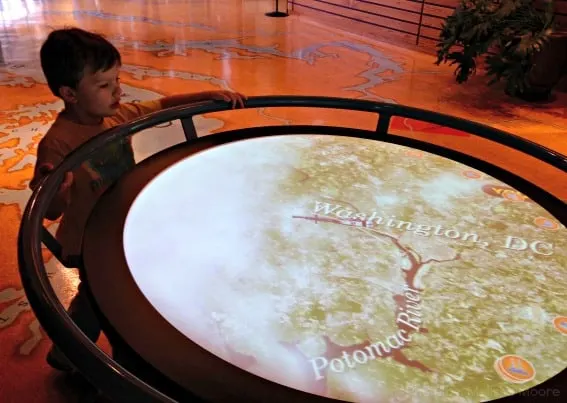 The most tangible way for kids to begin to understand the human impact on our bays, oceans, rivers, and lakes is to pick up the pollutants that they can actually see: the trash that has been washed down stream into these larger bodies of water. While I’ve taken kids of all ages from scouting groups to high school biology classes out to the shoreline of the San Francisco Bay to pick up trash, I’m not sure that I’ve ever taken a moment while we’re out on the beach to have them think about all of the pollutants that they can’t see, the nitrogen from agricultural fertilizers, and sediment washed downstream to the bottom of the bay. Pollution in a much more complex issue than a plastic bag washed up on the shoreline; it involves industry, agriculture, and the management of native and invasive species in the ecosystem. At the Robinson Nature Center on the banks of the Middle Patuxent River, my four-year-old son became obsessed with an exhibit that cleverly illustrated the sources of these pollutants and their locations in the Chesapeake Bay watershed area. In this digital exhibit, kids have the opportunity to pilot a helicopter over the Chesapeake Bay watershed displayed on a screen; farms, water treatment plants, factories, and local fisheries are marked on the map. When the digital helicopter lands on one of the sites, information is provided about the site’s impact on pollutants entering the bay. Of course, if you know where to look, it’s not hard to find information about the current state of our country’s watersheds, lakes, rivers, and estuaries. From reading a children’s book about how oysters clean and filter the water of the Chesapeake Bay to using the Internet to learn the most up-to-date statistics about the status of the blue crab, oyster, and rockfish populations, there are plenty of ways to learn more either before or after your family beach vacation.
The most tangible way for kids to begin to understand the human impact on our bays, oceans, rivers, and lakes is to pick up the pollutants that they can actually see: the trash that has been washed down stream into these larger bodies of water. While I’ve taken kids of all ages from scouting groups to high school biology classes out to the shoreline of the San Francisco Bay to pick up trash, I’m not sure that I’ve ever taken a moment while we’re out on the beach to have them think about all of the pollutants that they can’t see, the nitrogen from agricultural fertilizers, and sediment washed downstream to the bottom of the bay. Pollution in a much more complex issue than a plastic bag washed up on the shoreline; it involves industry, agriculture, and the management of native and invasive species in the ecosystem. At the Robinson Nature Center on the banks of the Middle Patuxent River, my four-year-old son became obsessed with an exhibit that cleverly illustrated the sources of these pollutants and their locations in the Chesapeake Bay watershed area. In this digital exhibit, kids have the opportunity to pilot a helicopter over the Chesapeake Bay watershed displayed on a screen; farms, water treatment plants, factories, and local fisheries are marked on the map. When the digital helicopter lands on one of the sites, information is provided about the site’s impact on pollutants entering the bay. Of course, if you know where to look, it’s not hard to find information about the current state of our country’s watersheds, lakes, rivers, and estuaries. From reading a children’s book about how oysters clean and filter the water of the Chesapeake Bay to using the Internet to learn the most up-to-date statistics about the status of the blue crab, oyster, and rockfish populations, there are plenty of ways to learn more either before or after your family beach vacation.
Where to Go
St Lucie’s Inlet, Martin County, Florida
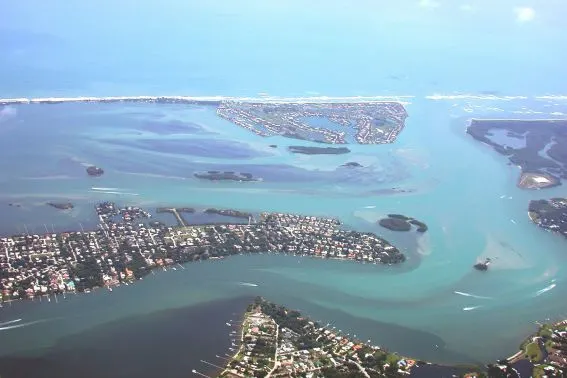 Photo Courtesy of Discover Martin County
Photo Courtesy of Discover Martin County
For many American families, a trip to the beach means a vacation to Florida. Parents imagine lazy days sitting under an umbrella, novel in hand as the kids catch waves or play in the sand. It turns out that a trip to Florida’s Atlantic coastline can be much more than a day at the beach; families can see dolphins, sea turtles, gators, and so much more when they visit the Sunshine State. That’s because much of the Eastern Coast of Florida is protected by barrier islands; the space between these islands and the mainland of Florida forms a 156 mile lagoon, the Indian River Lagoon. The Indian River Lagoon is North America’s most diverse estuary and it is home to nesting sea turtles, mangrove forests, and bottlenose dolphins. However, increasing population and housing developments have threatened the lagoon by encouraging problematic algae blooms, which ultimately cause a loss of sea grass which naturally cleans the lagoon water. Fortunately, in Martin County, areas around the St Lucie’s Inlet are being protected. Families can visit the Hobe Sound National Wildlife Refuge home to the endangered sand pine scrub forest and of some of most productive sea turtle nesting habitat in the United States. The national wildlife refuge is a place for families to experience undeveloped coastline and walk through protected wildlife habitat observing the organisms that live there. Neighboring the refuge is Jonathan Dickinson State Park. While still protecting the endangered forests and local wildlife, the state park also provides more educational programs including canoe rentals and boat tours of the Loxahatchee River. Consequently, a family vacation to Florida can also be a great opportunity for kids to learn about the creatures living in the oceans and nearby lagoon waters. As children interact with the sea creatures at Florida Oceanographic Coastal Center or stand up paddleboard with the manatees and dolphins on a beginner tour with Coastal Paddle Boarding, their appreciation for the animals will grow along with their desire to protect the environment in which the creatures live.
The Chesapeake Bay
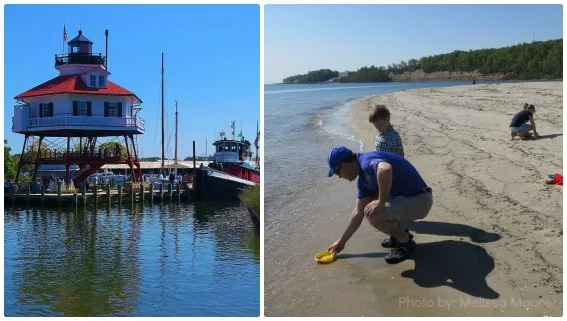 The Chesapeake Bay is the largest estuary in the United States, and about 18 million people live in the Chesapeake Bay watershed. The cities of Baltimore and Norfolk have been industrial centers on the bay for decades and now feature museums where families can learn about the history and ecology of the area. My kids and I enjoyed exploring both the USS Wisconsin and also connecting with a few horseshoe crabs in a touch tank at the Nauticus in Norfolk. In Baltimore we learned how oysters were packed at the Baltimore Museum of Industry. Less than a two-hour drive from Washington DC, Solomons Island in Calvert County is the perfect day trip or weekend getaway. Families can learn about the bay ecology at the Calvert Marine Museum then head out to the Flag Ponds Nature Park along The Calvert Cliffs to search for shark’s teeth. The Calvert Marine Museum may not be located in a major metropolitan area, but its focus on the organisms that live in the bay is unique. Visitors first walk through newly updated aquariums that show the fish, amphibians, and reptiles that call the bay home, then in the final room of the aquarium visitors are introduced to the invasive species that are creating an imbalance in the fragile bay ecosystem. If your family is looking for a true vacation on the Chesapeake Bay, drive through the Chesapeake Bay Bridge-Tunnel to get away from it all on the Eastern Shore. Relax on the beach of the Chesapeake in Cape Charles and enjoy some of the best seafood that the area has to offer at the Shanty overlooking the Cape Charles Marina. There’s so many fun places to go to learn about the Chesapeake Bay; check out a full list of our favorites here.
The Chesapeake Bay is the largest estuary in the United States, and about 18 million people live in the Chesapeake Bay watershed. The cities of Baltimore and Norfolk have been industrial centers on the bay for decades and now feature museums where families can learn about the history and ecology of the area. My kids and I enjoyed exploring both the USS Wisconsin and also connecting with a few horseshoe crabs in a touch tank at the Nauticus in Norfolk. In Baltimore we learned how oysters were packed at the Baltimore Museum of Industry. Less than a two-hour drive from Washington DC, Solomons Island in Calvert County is the perfect day trip or weekend getaway. Families can learn about the bay ecology at the Calvert Marine Museum then head out to the Flag Ponds Nature Park along The Calvert Cliffs to search for shark’s teeth. The Calvert Marine Museum may not be located in a major metropolitan area, but its focus on the organisms that live in the bay is unique. Visitors first walk through newly updated aquariums that show the fish, amphibians, and reptiles that call the bay home, then in the final room of the aquarium visitors are introduced to the invasive species that are creating an imbalance in the fragile bay ecosystem. If your family is looking for a true vacation on the Chesapeake Bay, drive through the Chesapeake Bay Bridge-Tunnel to get away from it all on the Eastern Shore. Relax on the beach of the Chesapeake in Cape Charles and enjoy some of the best seafood that the area has to offer at the Shanty overlooking the Cape Charles Marina. There’s so many fun places to go to learn about the Chesapeake Bay; check out a full list of our favorites here.
The Great Lakes
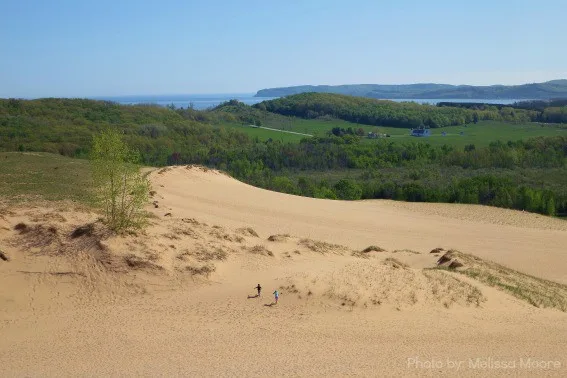 My first visit to Maryland’s Eastern Shore this past summer reminded me of a trip my husband and I took to Door County, Wisconsin and Michigan’s Upper Peninsula about seven years ago. There are certainly similarities between these regions; before bridges were built and summer tourists discovered these areas, the locals were dependent on the fish that they could catch. Just like the blue crabs and oysters of the Chesapeake, the Door County Fish Boils are an integral part of the region’s tradition and culture. Sampling some of the whitefish cooked up in a Door County Fish Boil is one way to learn about the ecology of the Great Lakes, but there are plenty of other places that your family can go to learn more. Duluth, located on the western edge of Lake Superior is one of the best places to learn about the ecology of the Great Lakes. Located on Duluth’s Harbor just steps away from Lake Superior, the Great Lakes Aquarium has tanks displaying the fish and creatures that you would likely see if you ventured into the waters off of Lake Superior’s remote Isle Royale National Park. After a morning at the aquarium, families can walk along the lake’s edge at Canal Park, featuring a lighthouse and the Lake Superior Maritime Visitor Center. Of course, getting outdoors and experiencing the natural beauty of the lakes will create lasting memories for children. There are two national lakeshores in Michigan, as well as one in Wisconsin and another in Indiana, maintained by the National Park Service. Families can enjoy a boat cruise, paddling, hiking, or even some time on the beach at Pictured Rocks National Lakeshore on the southeastern side of Lake Superior. Or, for a completely different experience, hike the dunes at Sleeping Bear Dunes on the shores of Lake Michigan near Traverse City; my kids loved hiking barefoot through the sand on a warm spring morning. Michigan, Wisconsin, and Minnesota do not hold a monopoly on the Great Lakes, Lake Erie and Lake Ontario also have plenty of lakeshore for families to discover. Presque Isle State Park in Erie, Pennsylvania is a great place to take the family bird watching, boating, or just enjoy a leisurely day on the beach. For a view, and to learn a bit about the area’s rich history, make sure not to miss The Tom Ridge Environmental Center. For more family fun exploring the Great Lakes, read about these Family-friendly Midwest Island Getaways.
My first visit to Maryland’s Eastern Shore this past summer reminded me of a trip my husband and I took to Door County, Wisconsin and Michigan’s Upper Peninsula about seven years ago. There are certainly similarities between these regions; before bridges were built and summer tourists discovered these areas, the locals were dependent on the fish that they could catch. Just like the blue crabs and oysters of the Chesapeake, the Door County Fish Boils are an integral part of the region’s tradition and culture. Sampling some of the whitefish cooked up in a Door County Fish Boil is one way to learn about the ecology of the Great Lakes, but there are plenty of other places that your family can go to learn more. Duluth, located on the western edge of Lake Superior is one of the best places to learn about the ecology of the Great Lakes. Located on Duluth’s Harbor just steps away from Lake Superior, the Great Lakes Aquarium has tanks displaying the fish and creatures that you would likely see if you ventured into the waters off of Lake Superior’s remote Isle Royale National Park. After a morning at the aquarium, families can walk along the lake’s edge at Canal Park, featuring a lighthouse and the Lake Superior Maritime Visitor Center. Of course, getting outdoors and experiencing the natural beauty of the lakes will create lasting memories for children. There are two national lakeshores in Michigan, as well as one in Wisconsin and another in Indiana, maintained by the National Park Service. Families can enjoy a boat cruise, paddling, hiking, or even some time on the beach at Pictured Rocks National Lakeshore on the southeastern side of Lake Superior. Or, for a completely different experience, hike the dunes at Sleeping Bear Dunes on the shores of Lake Michigan near Traverse City; my kids loved hiking barefoot through the sand on a warm spring morning. Michigan, Wisconsin, and Minnesota do not hold a monopoly on the Great Lakes, Lake Erie and Lake Ontario also have plenty of lakeshore for families to discover. Presque Isle State Park in Erie, Pennsylvania is a great place to take the family bird watching, boating, or just enjoy a leisurely day on the beach. For a view, and to learn a bit about the area’s rich history, make sure not to miss The Tom Ridge Environmental Center. For more family fun exploring the Great Lakes, read about these Family-friendly Midwest Island Getaways.
The Gulf Coast
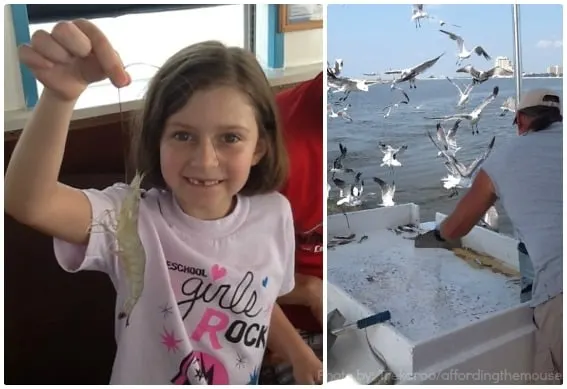 While the Chesapeake Bay and its watershed are huge, they have nothing on the Mississippi River and the Gulf of Mexico. The Mississippi River watershed is the fourth largest in the world and encompasses all or part of 31 US States. From swamps to barrier islands, the Gulf Coast has so many places for families to explore. The Audubon Aquarium of the Americas has tanks featuring animals from both the Gulf Mexico and the Mississippi River. In Alabama, Trekaroo families love the touch tanks at the Dauphin Island Sea Lab Estuarium where kids have the opportunity to touch horseshoe crabs. It is also one of the best places on the coast to learn about the ecological effects of the explosion of BP’s Deepwater Horizon Oil Rig and the subsequent oil spill in 2010. If you’re looking for an experience that won’t soon be forgotten, make sure to plan a swamp tour for your family’s visit to Louisiana; Cajun Pride Swamp Tours is a favorite of Trekaroo families visiting New Orleans. The wildlife is abundant, the swamp is well-preserved and there are plenty of gators to be spotted. Alternatively, a boat ride with Biloxi Shrimping Trip will teach your family everything you ever wanted to know about Mississippi’s local shrimping industry. Afterwards, stop in to learn even more at the Maritime & Seafood Industry Museum also in Biloxi. Many of the eco-tours available along the Gulf Coast are family run and operated; enjoy some Southern hospitality as you explore this beautiful area.
While the Chesapeake Bay and its watershed are huge, they have nothing on the Mississippi River and the Gulf of Mexico. The Mississippi River watershed is the fourth largest in the world and encompasses all or part of 31 US States. From swamps to barrier islands, the Gulf Coast has so many places for families to explore. The Audubon Aquarium of the Americas has tanks featuring animals from both the Gulf Mexico and the Mississippi River. In Alabama, Trekaroo families love the touch tanks at the Dauphin Island Sea Lab Estuarium where kids have the opportunity to touch horseshoe crabs. It is also one of the best places on the coast to learn about the ecological effects of the explosion of BP’s Deepwater Horizon Oil Rig and the subsequent oil spill in 2010. If you’re looking for an experience that won’t soon be forgotten, make sure to plan a swamp tour for your family’s visit to Louisiana; Cajun Pride Swamp Tours is a favorite of Trekaroo families visiting New Orleans. The wildlife is abundant, the swamp is well-preserved and there are plenty of gators to be spotted. Alternatively, a boat ride with Biloxi Shrimping Trip will teach your family everything you ever wanted to know about Mississippi’s local shrimping industry. Afterwards, stop in to learn even more at the Maritime & Seafood Industry Museum also in Biloxi. Many of the eco-tours available along the Gulf Coast are family run and operated; enjoy some Southern hospitality as you explore this beautiful area.
Plan a trip to Mississippi’s Gulf Coast with this itinerary.
Check out our kid-friendly Pinterest board on exploring Aquatic Ecosystems with Kids Follow Trekaroo Family Travel’s board Aquatic Ecosystems on Pinterest. 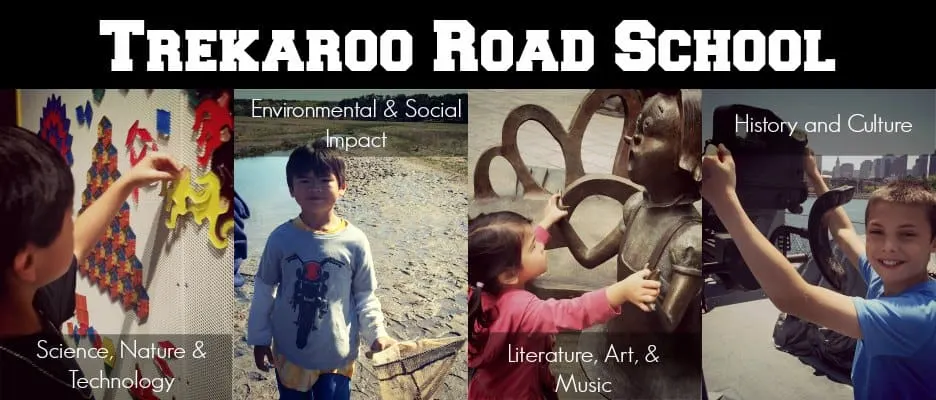 Ready to learn more? Check out our award-winning Road School Series on traveling and learning with your kids. From walking the steps of history to hands-on science & technology, to diving into literature, art, and music, and teaching your kids to understand environmental and social concerns, we’ve got a road school topic for your family to discover.
Ready to learn more? Check out our award-winning Road School Series on traveling and learning with your kids. From walking the steps of history to hands-on science & technology, to diving into literature, art, and music, and teaching your kids to understand environmental and social concerns, we’ve got a road school topic for your family to discover.
- 13 Great Family Friendly Hotels in Washington DC - April 11, 2025
- Blue Ridge Parkway Road Trip in Virginia - March 11, 2025
- Epic Eastern Canada Road Trip with Kids: Itinerary & Tips Before You Go - March 7, 2025

